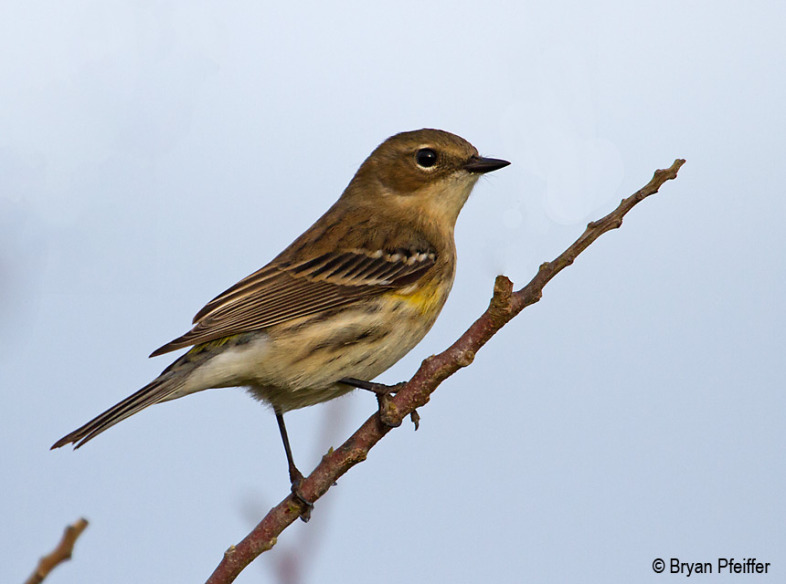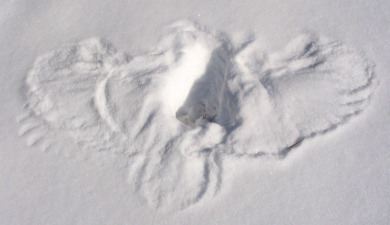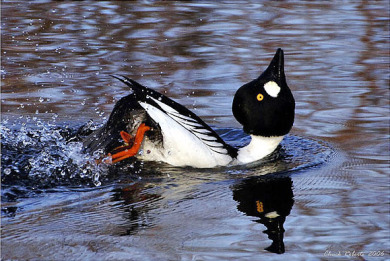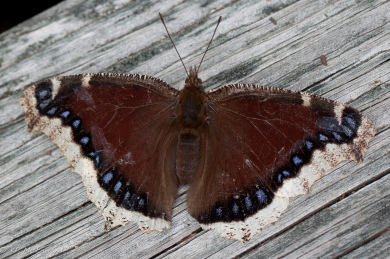By Kent McFarland and Bryan Pfeiffer

Yellow-rumped Warbler / © Bryan Pfeiffer
Even on these cold, short days, most of us might not be too far from warblers and butterflies. In this VCE Field Guide to December, we report on how animals adapt for winter, and how a few might even leave behind some nice impressions.
Our Winter Warbler
It is an aster in winter, spit in the wind, sun through the clouds – a force of nature called the Yellow-rumped Warbler. Find its buttery warmth even when life outside seems to groan or crunch or crack in the cold. In his tribute to “butter-butts,” VCE Research Associate Bryan Pfeiffer says that it takes guts to be a warbler in winter. Bryan describes the Yellow-rump’s “retrograde reflux of intestinal contents,” which allows the yellow-rump to eat far more than mere insects to make it through the cold. Read it on Bryan’s blog.
Wing Prints
 With all the early snow in the U.S. this winter, birds have been making impressions – literally. We’re seeing various wing prints in the snow. It makes us wonder about the reliability of identifying prints made here in Vermont – most likely by Barred Owl, Great Horned Owl, Ruffed Grouse or Wild Turkey. Can we get them right? Kent McFarland and Bryan Pfeiffer report on the VCE blog.
With all the early snow in the U.S. this winter, birds have been making impressions – literally. We’re seeing various wing prints in the snow. It makes us wonder about the reliability of identifying prints made here in Vermont – most likely by Barred Owl, Great Horned Owl, Ruffed Grouse or Wild Turkey. Can we get them right? Kent McFarland and Bryan Pfeiffer report on the VCE blog.
Kinglets in the Cold
Weighing less than a nickel and not much larger than your thumb, Golden-crowned Kinglets are the smallest birds to winter in the New England woods. How does a bird this small stay alive during the long and cold winter night? Larger animals have a lower surface-to-volume ratio than smaller animals. As a result, they radiate less body heat per unit of mass and are therefore able to stay warm using less energy. In 1847, Karl Bergmann, a German biologist, used this principle to show that within most warm-blooded species, body mass increases with latitude and colder climates. Kinglets are tiny; their small size seems to break Bergmann’s rule. VCE Conservation Biologist Kent explains on his blog, One Square Meter.
Icy Romance
 The drama begins each morning in the frigid waters of Lake Champlain and other cold places across North America: Common Goldeneyes are getting hot. These perky ducks bob and dive, lunge and flutter, cavort and compete. Three months before our woods will glow with a rainbow of migrating songbirds, ducks are already courting – proof that icy water doesn’t necessarily put a chill on carnal desire. Read more on Bryan’s blog about early courtship among ducks.
The drama begins each morning in the frigid waters of Lake Champlain and other cold places across North America: Common Goldeneyes are getting hot. These perky ducks bob and dive, lunge and flutter, cavort and compete. Three months before our woods will glow with a rainbow of migrating songbirds, ducks are already courting – proof that icy water doesn’t necessarily put a chill on carnal desire. Read more on Bryan’s blog about early courtship among ducks.
“Frog-sicles”
Just a few months ago they were wandering through the woods. But today they’re frozen. Just weeks ago, ice began to form inside the bodies Wood Frogs. Glucose levels increase in their blood by as much as 200-fold in just eight hours, creating an antifreeze that preserves their tissues and organs through the long winter ahead. Read more in Kent’s post about frog-sicles.
Even in the Darkest Days There’s a Butterfly Near You
Mourning Cloak butterflies are one of the earliest to appear flying about in spring. They spent the fall fluttering about feeding and storing abdominal fat. Before winter arrived, they found a space to hide – in the woodpile, a hollow tree, a cracks in a rock, or inside an old shed. In these protected and somewhat insulated hideouts they enter diapause, a state of dormancy. They become sluggish as the temperature drops. The freezing point of their cell tissue is lowered by an increased content of sugars, which act as an antifreeze. Mourning Cloaks produce sorbitol, a sugar alcohol obtained by the reduction of glucose. Sorbitol is also a sugar substitute that is often used in diet foods and it can also be found in plants in the genus Sorbus, represented by Mountain Ash in New England. Using electrical conductivity, biologists in Alaska found that Mourning Cloaks do not freeze until the temperature reaches -22 F, something that their cozy hideout should never experience.

